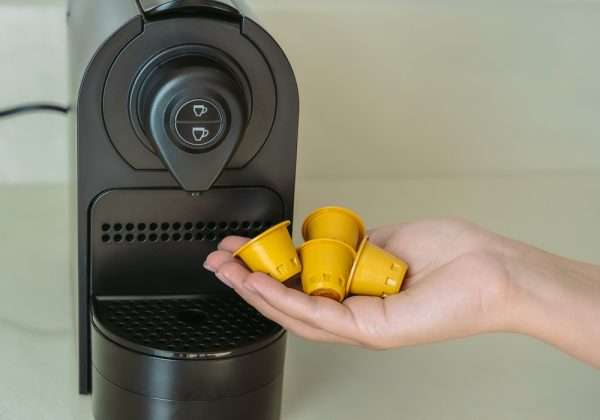There are several reasons you could find yourself wondering whether or not you can use a coffee pod twice. They can be on the pricy side, so using the same one twice would essentially get you a two-for-one deal and more bang for your buck.
Alternatively, there’s been a lot of buzz about coffee pods and their impact on the environment, so if you’re feeling particularly environmentally conscious, but can’t imagine not having your coffee pods in your life, you may be wondering if you can soften the blow by using one pod twice. Well, I’m about to spill the tea… er, I mean coffee!
Technically there’s nothing stopping you from popping the same coffee pod into the brewer twice and having it run again unless you have a high-end product that can tell when the pod has already been punctured. But should you use the same coffee pod twice? Probably not.
What happens if you use a coffee pod twice?
One of two things will likely happen if you try to use a coffee pod twice in a row. First, your machine will either be able to tell that it has already been punctured or just be confused by it and therefore, not brew any coffee until you pop a new pod in.
The other possibility is that your second cup of coffee will brew just fine, but it won’t taste nearly as good as the first time around. If you’re making two small cups of coffee, you may be able to get away with it, but there’s a good chance it will still taste weaker or more watered down the second time around.
Plus, the longer it sits around, the more flavor the pod itself will lose, so unless you’re brewing them back to back, those grounds definitely aren’t going to suddenly taste better after sitting around for a while.
Coffee pods: A History
This all had me wondering where coffee pods even originated. They seem like a relatively recent product to hit the market, but I was very wrong about that. As it turns out, coffee pods were actually introduced by Nespresso in the 1980s. They took hold in kitchens across Europe, marketed as a way to enjoy espresso without even having to leave home.
Keurig and other competitors came along in the 1990s and by the early 2000s, coffee pods and their accompanying machines were all the rage. Today, they remain popular, with many companies entering the market with just the coffee pods themselves, not bothering to try to compete with the brewers that already exist.
The benefits of coffee pods
Coffee pods have made brewing a cup of coffee, specialty coffee beverage, or espresso easier than ever. With the machine in your kitchen and an abundance of pod varieties in stores and online, there’s no need to visit the local coffee shop if you’re running late to work.
Not to mention, each individually sealed pod retains its freshness far longer than a giant container of coffee grounds can. Each time you brew coffee from a pod, you get that intense, just-opened coffee aroma that really can’t be beaten.
Plus, clean-up is so easy! All you have to do is chuck the pod in the garbage when you’re done and that’s it. You don’t have to worry about spilling grounds and there’s no coffee pot to clean. This is especially handy in office settings where no one wants to be responsible for taking care of the communal coffee maker. Aside from adding water, it pretty much takes care of itself.
Coffee pods and the environment
This is where the dark side of coffee pods comes into play. Would you believe that the inventor of the K-Cup coffee pod, used in Keurigs, actually regrets inventing it? Yep, believe it!
At the time, he actually had the environment on his mind, thinking that, office workers not running out to coffee chains, and instead using coffee pods to get their fix, would neutralize the environmental impact by eliminating so much waste with single-use cups.
Alas, this was not the case, as the use of Keurigs soared far beyond the office and into the household, wreaking havoc on the idea that the waste would balance out.
As it turns out, most coffee pod varieties are either not biodegradable or they’re a pain in the neck to recycle. Nespresso pods are easier than K-Cups to recycle, but still not easy.
You’ll be hard-pressed to find anyone who actually properly recycles K-Cups, as they have to be separated into three different types of recycling that are usually handled by different facilities. Unfortunately, it’s a lot of effort that most people aren’t willing to put in and landfills continue to be loaded with coffee pod plastics.
Single-use coffee pod alternatives
Aside from using the same coffee pod twice to lessen your impact on the environment, there are some better options out there that will actually make more of a difference than the two-for-one option.
- Opt for compostable coffee pods, which are single-use, but are completely sustainable and eco-friendly
- Try a pod that’s actually meant to be reusable. But instead of just twice, you can reuse it for far longer
- Quit the pods altogether in favor of drip coffee
There’s no right or wrong answer here. Using a coffee pod twice will save you money, but at what cost? The flavor the second time around won’t be right and your machine may not even allow you to do it.
Plus, the environmental impact of using a pod twice is kind of a drop in the bucket–it’s not significant enough to combat the BILLIONS of pods that will head to the landfill every year.
Depending on your reasoning, feel free to double up on those pods, but take a moment to consider the pros and cons. If it’s a cost-saving measure, then, by all means, go for it. But if it’s an attempt to save the planet, maybe consider one of the options above instead.

